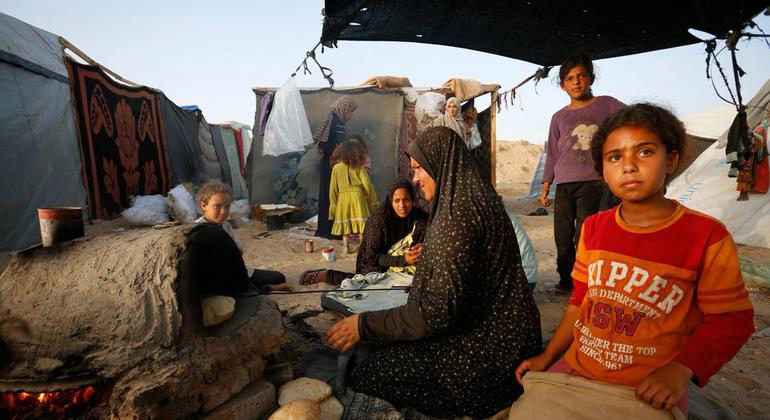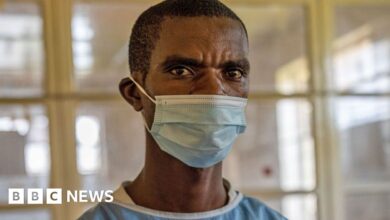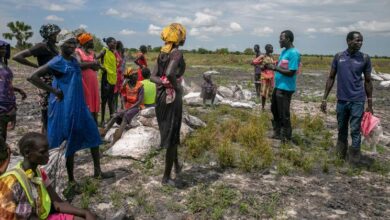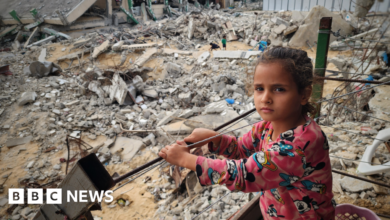Warning of new famine in Gaza, where many families have been without food for days

According to the latest UN-collaborated IPC report on hunger levels, 96% of the population – about 2.15 million people – face acute food insecurity at “crisis” levels or higher. . It is level three of the Integrated Food Security Phase Classification (IPC) index (see our explanation of the IPC system here).
The IPC update notes that, of this figure, nearly half a million people are suffering from “catastrophic” conditions (IPC level five), highlighting the “high risk” of famine across the Strip. Gaza “as long as the conflict continues and humanitarian access is limited.” ”.
Critical access
At the same time, the update pointed to “a small improvement” in the food security situation in the northern provinces of Gaza, where famine is feared by the end of May.
“The improvement shows the difference greater access can make,” the United Nations World Food Program said.WFP) in response to the IPC findings. “Increased northern food supplies and nutrition services have helped reduce the worst levels of poverty, leaving a The situation is still desperate.”
Not an inch is safe
A UN aid worker said on Tuesday that “not an inch of safety remains” in Gaza, where the laws of war continue to be flouted to the detriment of civilians and humanitarian organisations in the divided enclave.
Speaking to journalists in Geneva after her second deployment to Gaza, Yasmina Guerda from the United Nations aid coordination office (OCHA) said providing aid there had become a frustrating “daily puzzle” that left malnourished children without the help they needed to save their lives.
“Direct observation in the field every day is that there is not a single centimeter of safety left in Gaza. You can’t be anywhere and be sure that there won’t be any attacks on you that night,” she speaks.
After nearly nine months of intense Israeli bombing and ground operations prompted by the Hamas-led attacks and hostage-taking on October 7, basic needs are greater than ever for the people. Gaza was forced to leave their homes immediately, following repeated evacuation orders. issued by the Israeli army.
“You have 10 to 15 minutes to leave your building because it is about to be bombed. Your child is sleeping in the next room,” Ms. Guerda said.
“You have to make split-second decisions to decide what to bring, what is necessary. How do you determine what is essential? Birth certificates, IDs, baby formula… that is the story I have heard over and over again by those fleeing Gaza City, Jabalia, Khan Younis, Deir Al-Balah and of course now Rafah.”

More than 35 displaced people were killed when an Israeli airstrike hit a school run by UNRWA in Nuseirat, Central Gaza.
The Nuseirat Nightmare
Recalling Israel’s military operation two weeks ago to release four Israeli hostages being held in Nuseirat in central Gaza that left hundreds dead and injured according to local health authorities, humanitarian officials of the The United Nations emphasized that residents of the surrounding area received no such warnings.
“They’re just trying to dine on whatever they can get their hands on that day The bombing began and lasted for two hours and tank shells and gunfire. We were working a few kilometers away and the walls, doors, and windows of our building were all shaking. We don’t know what’s going on. Then we found out.”
After the attack, Ms. Guerda described arriving at the field hospital and finding children with missing limbs “staring into space, too shocked to make sounds or tears. For those who survived the bombing of their neighborhood and escaped on time, it was just the beginning of the nightmare.”
Getting humanitarian aid to these survivors and the more than one million people who fled Rafah in southern Gaza within 10 to 14 days remains extremely difficult, especially since the closure of Israel’s military operation. important border crossing there in early May, OCHA officers continued.
“Delivering aid in Gaza is a daily puzzle,” she said, pointing to “the daily fighting, the shortage of everything you need, the regular attacks on our reserves, tons of administrative obstacles, poor, weak internet.” phone networks, destroyed roads, you name it.”
“We spent hours waiting at checkpoints, coordinating and compromising to find a way through.”
10 children lose their legs every day
Meanwhile, the head UNRWAThe United Nations agency for Palestinian refugees said on Tuesday that every day in Gaza, 10 children lose one or both legs amid ongoing Israeli bombing.
Philippe Lazzarini, Commissioner General of UNRWA, also condemned the overnight attack on one of the agency’s schools in Gaza City, which left some 12 people dead and 22 injured.
He said the attack brought the total number of UN facilities “attacked, destroyed or targeted since the war began” to 190, more than half of UNRWA facilities in the Gaza Strip .
Concerns about ‘suppression’ of anti-war protesters
In a related development, a leading independent rights expert expressed concern about the recent “violent crackdown” on anti-war protesters on campuses in the United States, where protesters The situation is calling for a ceasefire and a review of the relationship between its organizations and Israel.
“What is alarming is the unequal treatment of those who express their views,” he said. Farida Shaheed, Special Rapporteur on the right to education.
“Pro-Palestinian protesters, including Jewish students, faced disproportionately harsh reactions, allegedly because of their anti-Semitic views with criticism of the State of Israel being associated with anti-Semitism,” she told the United Nations Eastern Human Rights Association in Geneva on Monday.
The independent expert, who does not work for the United Nations, noted that all governments “must prohibit incitement to violence, hostility or discrimination” while emphasizing that the expression of political views Criticism is not a basis for restricting freedom of speech.




